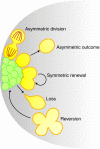The stem cell niche: lessons from the Drosophila testis
- PMID: 21693509
- PMCID: PMC3119301
- DOI: 10.1242/dev.056242
The stem cell niche: lessons from the Drosophila testis
Abstract
In metazoans, tissue maintenance and regeneration depend on adult stem cells, which are characterized by their ability to self-renew and generate differentiating progeny in response to the needs of the tissues in which they reside. In the Drosophila testis, germline and somatic stem cells are housed together in a common niche, where they are regulated by local signals, epigenetic mechanisms and systemic factors. These stem cell populations in the Drosophila testis have the unique advantage of being easy to identify and manipulate, and hence much progress has been made in understanding how this niche operates. Here, we summarize recent work on stem cells in the adult Drosophila testis and discuss the remarkable ability of these stem cells to respond to change within the niche.
Figures



References
-
- Affolter M., Basler K. (2007). The Decapentaplegic morphogen gradient: from pattern formation to growth regulation. Nat. Rev. Genet. 8, 663-674 - PubMed
-
- Arbouzova N. I., Zeidler M. P. (2006). JAK/STAT signalling in Drosophila: insights into conserved regulatory and cellular functions. Development 133, 2605-2616 - PubMed
-
- Barroca V., Lassalle B., Coureuil M., Louis J. P., Le Page F., Testart J., Allemand I., Riou L., Fouchet P. (2009). Mouse differentiating spermatogonia can generate germinal stem cells in vivo. Nat. Cell Biol. 11, 190-196 - PubMed
-
- Becker P. B., Horz W. (2002). ATP-dependent nucleosome remodeling. Annu. Rev. Biochem. 71, 247-273 - PubMed
Publication types
MeSH terms
Substances
Grants and funding
LinkOut - more resources
Full Text Sources
Medical
Molecular Biology Databases

